 Sex Criminals #1 — Writer: Matt Fraction; Art: Chip Zdarsky
Sex Criminals #1 — Writer: Matt Fraction; Art: Chip Zdarsky
You know how people say, about great sex, “time stopped”? Well, this is a story about a girl who finds out that, when she has an orgasm, time literally stops; it’s a mutant power triggered by the rush of endorphins or serontin or dopamine or whatever. In the wrong hands, this could be a disastrous premise for a series, all snickering adolescent exploitation, but fortunately Fraction and Zdarsky are made of sterner stuff; Fraction’s got a deep humanism that’s at the core of all of his best writing, making us care about and relate to his characters, and it’s on full display here, while Zdarsky’s art, cartoonier in the younger-girl flashbacks and more realistic in the grown-up present, is assured, stylish, sexy and just about perfect (and, in an age of great comic colorists, he holds his own; colors are a big part of the effects here, and they’re just about perfect too). Read this first issue and just try not to come back for the next one: out of a pile of really good Image books that came out this Wednesday, it’s the comic of the week.
Saga #14 — Writer: Brian K. Vaughan; Art: Fiona Staples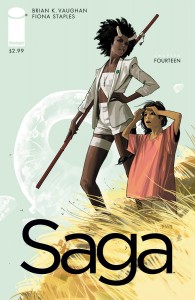
… and here’s another one — but we all already knew that, didn’t we? (Vaughan and Staples have won a ton of awards for this book over the last few months — including Eisners and a Hugo — and he also executive-produced Under the Dome, the top-rated drama on TV over that same time period. And what did you do with your summer, besides lie on the coach, play video games and eat Cheetos?) This issue continues the high-quality storytelling, as Alana, Marko, his mom, the baby and the ghost visit with Heist the writer, while on another planet Will, Gwen, Sophie and Lying Cat interrelate and wait for a lead; we also meet Alana’s mom, who shows up, in a subtle shout-out to Dome, with monarch butterfly wings. All of this looks gorgeous as always, thanks to Staples’s attractive, careful art; there are something like 15 characters here, and every single one is a separate, unique, real-looking person, most of them good-looking, even though they represent maybe nine different alien races. If you really want to get in on this award-winning story properly, start with the trades — but this single issue should let you know why that would be a great idea.
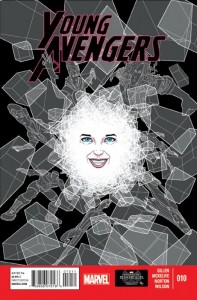 Young Avengers #10 — Writer: Kieron Gillen; Art: Jamie McKelvie with Mike Norton
Young Avengers #10 — Writer: Kieron Gillen; Art: Jamie McKelvie with Mike Norton
Only a few Marvel books made the list this week, thanks to all those silly 3-D DC covers, but I can’t let the opportunity pass without another shout-out to this book. It’s almost all conversations, but from the opening sequences, where the alien Mother makes a meal of the caption box, through the appearances of Loki (whose plans-within-plans are even darker than we thought), Leah, an encounter group involving three of Noh-Varr’s ex-girlfriends, and the cliffhanger ending, it’s confident, twisty and exciting storytelling, with McKelvie’s art and Gillen’s words meshing as only the best creative teams can. Please buy this book, so these two can keep doing this for at least another couple of years.
FF #12 — Writer: Lee Allred; Art: Michael Allred
Matt Fraction is listed as co-storyteller, but he’s no longer scripting this (too many other books, with the upcoming Inhumans series apparently being the last straw). However, Lee is Michael’s brother, and with wife/sister-in-law Laura supplying the psychedelic colors, this is decidedly a family affair. Wanna see Scott Lang’s dramatic dreams? Maximus the Mad and Julius Caesar discussing the fine points of world conquest? Dr. Doom debating with his future-self Immortus about whether he’ll end up as Doom the Conquerer? Adolf, the Impossible Man’s son, reading Fantastic Four comics starring his dad, getting a tutorial from the other kids about how, while heroes are in primary colors, green and purple are for bad guys, becoming outraged, and then finally being distracted by Val’s TV cartoons involving shojo-anime versions of a dozen Marvel heroes (“So sparkly. So frilly…”)? The building of the space-time portal that may or may not bring the regular FF back? (That last one actually advances the plot, even if it isn’t nearly as interesting as the anime — but it helps to justify the happy chaos that’s the rest of this book.)
 The Simpsons’ Treehouse of Horror #19 — Creators: Doug Moench/Mike Kazaleh; Ian Boothby/Tone Rodriguez/Andrew Pepoy; Len Wein/Dan Brereton
The Simpsons’ Treehouse of Horror #19 — Creators: Doug Moench/Mike Kazaleh; Ian Boothby/Tone Rodriguez/Andrew Pepoy; Len Wein/Dan Brereton
Yes, kids, this book has been coming out every Hallowe’en for 19 years, sometimes with Bongo’s regular creators and sometimes with cool guests; this year, the Wein/Brereton offering at the end, with Brereton’s painted mashup of the Simpsons and H.P. Lovecraft’s Cthulhu mythos, is the biggest treat, but the other two stories, involving bad school cafeteria food turning the kids into aliens and Homer in a Cabin in the Woods-style haunted house, are lots of fun too. For $4.99, this is a great way to start forgetting the Arizona summer and getting into the fall/holiday spirit (insert plug for all the monster/horror comics and magazines we just put up on all the AABC walls here…).
Jupiter’s Legacy #3 — Writer: Mark Millar; Art: Frank Quitely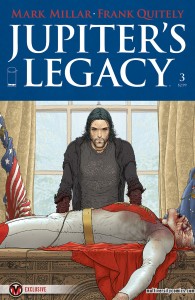
Say what you want about Millar, his 14-year-old cynical/romantic view of the world, and his dialogue tics, but he’s great at delivering cheap thrills, and he’s great at attracting top-tier artists to help him do it. Quitely could make a tax return interesting, and watching him draw stylishly-coifed and -costumed people doing horrible things to one another is more than enough reason to read this book.
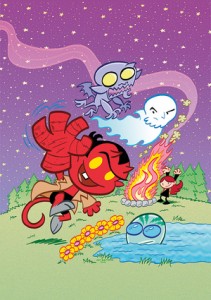 Itty Bitty Hellboy #2 (of 5) — Writers: Art Baltazar and Franco; Art: Art Baltazar
Itty Bitty Hellboy #2 (of 5) — Writers: Art Baltazar and Franco; Art: Art Baltazar
This is from the team that brought you Tiny Titans and Superman Family Adventures, and they bring the same kid-friendly, minimalist, Crayola-riffic style to Mike Mignola’s signature character and his friends. It’s like a Harvey Hot Stuff comic from some weird alternate dimension, and it offers just as much in-joke-packed, sly fun as those other titles. Not many books can combine a fan base of six-year-olds and Hellboy/horror enthusiasts, but this one does it with charm and style to spare.
Empowered Special #5 — Writer: Adam Warren; Art: Takeshi Miyazawa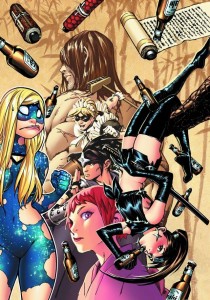
Warren’s graphic-novel series about a C-level-but-plucky superheroine and her friends is about to publish its eighth volume, a triumph of indy fan-building, and this occasional comic that supplements it (with artists other than Warren, who does all the work on the main volumes) is a good sample of its charms. Here, the focus is on best-supporting-martial-artist Ninjette, who, over an evening and nine beers, reveals much about her origin, life, and bff status with Emp. Warren knows a lot about Japanese comics and society (he seems to know a lot about everything, one of the qualities that makes him such a good writer), and Miyazawa, probably best known for his work on Marvel’s Mary Jane, Runaways and Ultimate Spider-Man, is a good fit (despite his name, he’s Canadian, but works in a modern-manga style); this book does its job of intriguing and attracting readers to the main series very well.
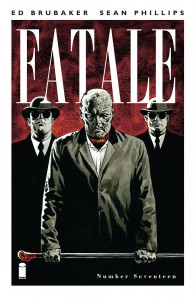 Fatale #17 — Writer: Ed Brubaker; Art: Sean Phillips
Fatale #17 — Writer: Ed Brubaker; Art: Sean Phillips
I’ve sung the praises of this series before, and its track record speaks for itself: Brubaker and Phillips just keep weaving tales of their title… well, not “heroine” here, but protagonist, and it promises to keep going for a good long time. This episode is the middle chapter of a longer story, so it isn’t the best place to start — but there’s a four-page ad in the back for the three trade collections of this, plus the 15 other trades they’ve amassed in a decades-long collaboration of the shadowy criminal underworlds they imagine so well.
And now, the last week of DC villain books:
Joker’s Daughter (Batman: The Dark Knight #23.4) — Writer: Ann Nocenti;  Art: Georges Jeanty
Art: Georges Jeanty
Yes, this is the book everyone wants, thanks to DC’s manipulation of the market for it — but is it any good? Well, it isn’t bad; Nocenti’s too good a writer for that. On the other hand, she’s never quite clicked for me. I think her writing lacks affect; it’s got a flatness, a lack of pizzazz, that makes it seem like something’s always about to happen, but nothing ever quite does (this is why I didn’t love her long run on Daredevil back in the day; I could see what she was trying to do, but it always seemed to take forever for her to actually do it). Also, naming the character “Duela,” and giving her a half-scarred face, is a signal to pre-New 52 DC continuity buffs that she should actually be Duela Dent, Two-Face’s daughter. She isn’t (unless the origin here is leaving things out), and she’s not the actual Joker’s daughter either , so having her find the Joker’s now-detachable face floating in the water and put it on just feels too convenient and manipulative. Jeanty’s art is fine; my only quarrel is that, since he’s spent the last five years drawing pretty much just Buffy the Vampire Slayer, this book looks a lot like an episode of that series, just without any Slayers in it. For all of its buzz, this comes off as just an average comic.
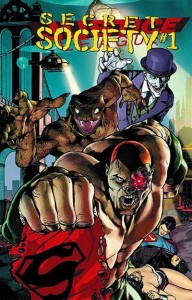 Secret Society (Justice League #23.4) — Writers: Geoff Johns and Sterling Gates; Art: Szymon Kudranski
Secret Society (Justice League #23.4) — Writers: Geoff Johns and Sterling Gates; Art: Szymon Kudranski
The title and cover make it look like this book is actually about, you know, the Secret Society of Super-Villains, which would promise some excitement… but it’s not; it’s about the Earth-Three Alfred, along with that dimension’s Owlman, Joker and Dick Grayson, and how Alfred ended up on DC-Earth to trigger Trinity and Forever Evil. Thanks to being co-written by Johns, it feels much more tied-in to current continuity, and a “real” tie-in to the event story, than many of the villain books — but, still, not that much happens, and the art’s so shadowy and murky that it takes maybe three minutes to read, and is instantly forgettable.
Ocean Master (Aquaman #23.2) — Writer: Tony Bedard; Pencils: Geraldo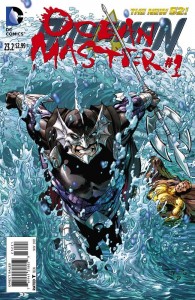 Borges; Inks: Ruy Jose
Borges; Inks: Ruy Jose
Co-plotted by Johns, this is another book that feels more like a tie-in than just another origin story; it’s about Orm, Aquaman’s brother who ruled Atlantis, invaded the surface world in revenge for what he thought was an attack (and turned out not to be), killed lots of people and ended up in prison. That prison gets busted up by the chaos following Forever Evil #1, and Orm gets out, and decides what to do next. This comes the closest of all this week’s books to reading like a regular issue of the parent comic — just without Aquaman ever showing up — and Orm comes off as genuinely conflicted, not “evil,” or even a villain, in the sense that almost all the other cover-featured characters have been. If you’ve been reading the regular title, you’ll probably want this too — and the water on the cover offers one of the better 3-D effects, too.
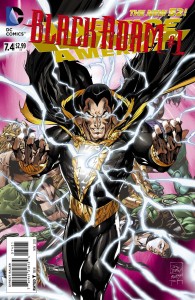 Black Adam (Justice League of America #7.4) — Writer: Sterling Gates; Pencils: Edgar Salazar; Inks: Jay Leisten
Black Adam (Justice League of America #7.4) — Writer: Sterling Gates; Pencils: Edgar Salazar; Inks: Jay Leisten
Johns gets co-plotting credit on this book, too, and, while there’s a little bit of origin involved, it’s mostly about getting Black Adam resurrected from the pile of ash Johns left him in the Shazam! series from the backs of the Justice League books a few months ago, installed as the protector of Kahndaq, and positioned as a (possible) opponent for the Forever Evil bad guys. So-so art, although there are two decent splash pages featuring Adam, and it’s another book that offers some events that will probably be important in continuity over the next few months.
Parasite (Superman #23.4) — Writer/Artist: Aaron Kuder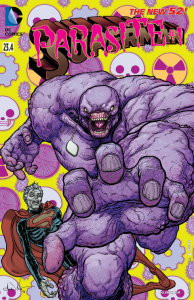
Now we’re getting into the books that are pretty standard in content — origin of the bad guy, plus an ending where bad guy gets out of prison because, you know, chaos from Forever Evil, and now he’s loose in the world again, and cue ominous music and fade out. This one’s enlivened by Kuder; it’s the only one of these comics where one creator is both artist and writer, and that gives it a unity of vision that helps it stand out. Also, the Parasite is always fun to draw (and Kuder’s style takes to him well), and making the pre-powers version of him, not evil, but just a general jerk is kind of appealing, too, in an avoid-the-cliche kind of way.
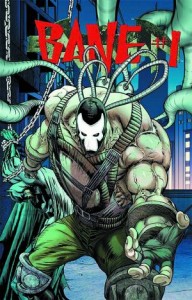 Bane (Batman #23.4) — Writer: Peter Tomasi; Art: Graham Nolan
Bane (Batman #23.4) — Writer: Peter Tomasi; Art: Graham Nolan
Really standard, without even an origin: Bane gathers his followers in Santa Presca, and they all get in a big boat and sail to Gotham City, where he will, apparently, eventually fight to take it over from the Forever Evil bad guys so he can rule it himself, in a mini-series tie-in to be launched soon. Totally like every other Bane story ever written, except that with no Batman or other hero to have conflict with, he’s just a big boring drug-addict jerk. Oh, and the 3-D cover looks stupid.
Metallo (Action Comics #23.4) — Writer: Sholly Fisch; Art: Steve Pugh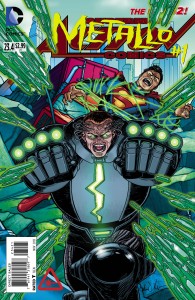
No origin here, either — the former John Corben goes crazier and crazier, and the Army decides to take him out, and they don’t, and things blow up and the Secret Society decides to recruit him as a full-time bad guy. This falls into the trap that a lot of these second-tier villain issues have: it’s full of depressingly-unlikeable characters, with no one to root for and nothing special enough about the art or story to justify buying it.
 Sinestro (Green Lantern #23.4) — Writer: Matt Kindt; Art: Dale Eaglesham
Sinestro (Green Lantern #23.4) — Writer: Matt Kindt; Art: Dale Eaglesham
Since the GL books are set in space, they have little connection to the Forever Evil series — Mongul was like that, and so is this book. Its title villain having “died,” it’s in the form of a rehash of his life, from one of his followers. The Kindt script is OK, and Eaglesham offers some nice page designs, but this is a story that any GL fan is already very familiar with, and, since it doesn’t resurrect its character at the end or add anything new to the recap. it’s very easy to skip.
Man-Bat (Detective #23.4) — Writer: Frank Tieri; Pencils: Scot Eaton; Inks:  Jaime Mendoza
Jaime Mendoza
With Batman missing, Man-Bat tries to fill his cowl, with predictable results. No Tieri jokes here, but this reads like exactly the same old Jekyll/Hyde pastiche that’s at the core of every Man-Bat story, and adds nothing new to it. One of the better 3-D covers, though, with lots of flying bats enhancing the effect nicely.
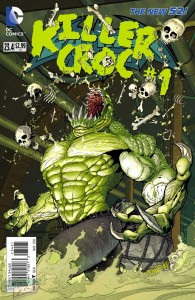 Killer Croc (Batman and Robin #23.4) — Writer: Tim Seeley; Art: Francis Portela
Killer Croc (Batman and Robin #23.4) — Writer: Tim Seeley; Art: Francis Portela
As Gotham City, minus any heroes, descends into anarchy, Croc and the discarded children and homeless adults he’s formed into an army stake out their territory in the sewers underneath the city, and bring savage justice on a gang of crooked cops; in between, we get flashbacks to his origin as a put-upon scaly kid. Decently written by Seeley (of Hack/Slash and Revival fame), and it manages to avoid many of the cliches associated with the character, and make him more sympathetic than most of the other bad guys. I gotta say, though, between this and the gang in Joker’s Daughter, those are some awfully crowded sewers Gotham has….
First Born (Wonder Woman #23.2) — Writer: Brian Azzarello; Art: ACO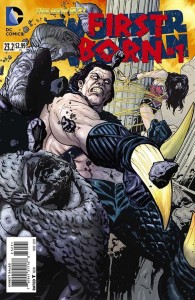
Azzarello’s the regular WW writer, so, like Ocean Master, this reads much like a regular episode of its parent book, only minus the lead hero; it’s not tied in to Forever Evil at all, and instead explores the mythological origins of its title character, and sets up conflicts that will eventually pay off in the regular comic. If you’re a loyal reader of Wonder Woman in its current new-52 incarnation, you’ll probably want this — although, if you’re not, it won’t offer anything of much interest.
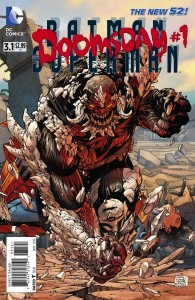 Doomsday (Batman and Superman #3.1) — Writer: Greg Pak; Pencils: Brett Booth; Inks: Norm Rapmund
Doomsday (Batman and Superman #3.1) — Writer: Greg Pak; Pencils: Brett Booth; Inks: Norm Rapmund
This is more of a General Zod story than a Doomsday one — the monster is just a convenient way for Zod to give Kryptonians a common enemy, and toughen them up, and, hey, if a few million have to die, that’s the price you gotta pay — omelets and eggs, right? It really oughta be a Supergirl substitute, since Batman has nothing to do with it, and it’s written as a flashback to Kara/Supergirl’s childhood, with her listening to the tale and then encountering a spectral Phantom Zone Zod. Pak and Booth make it a decent, if not particularly noteworthy, story, so Supergirl fans will probably like this the most.



